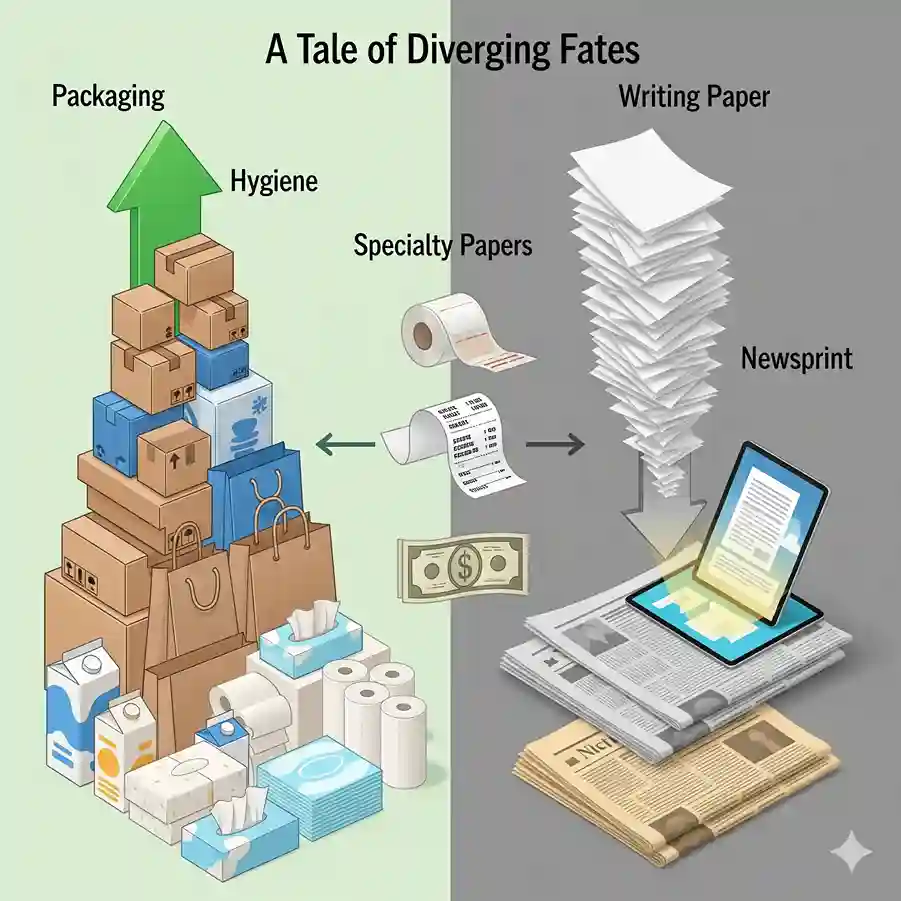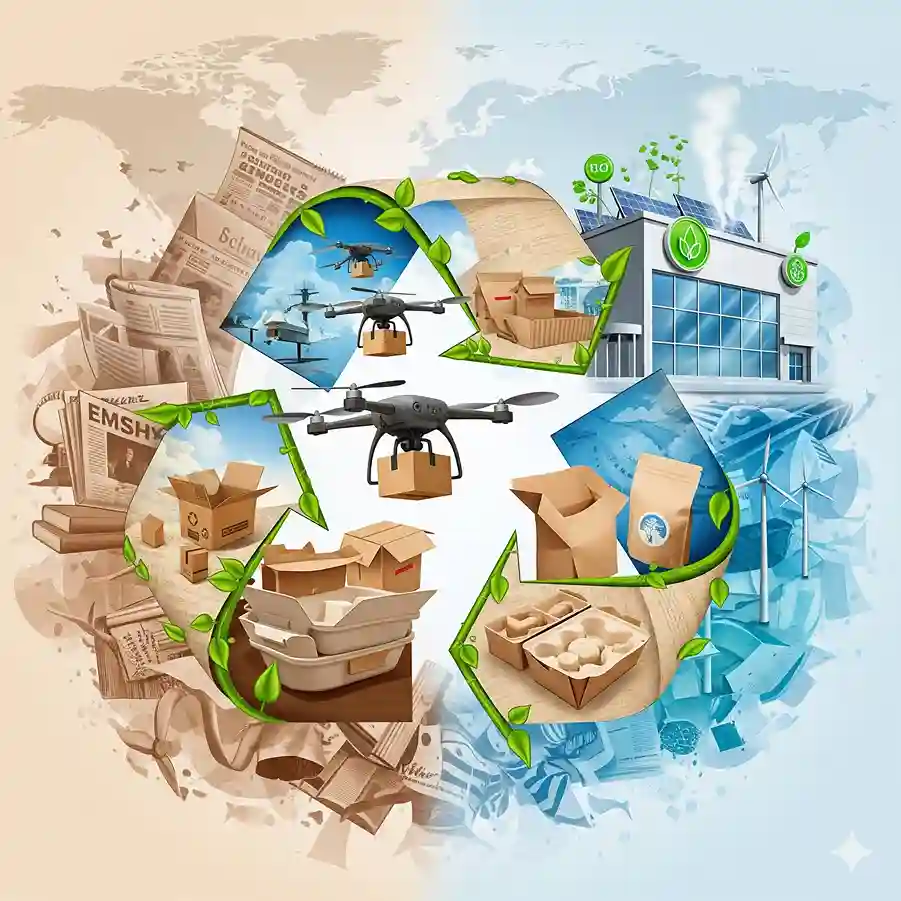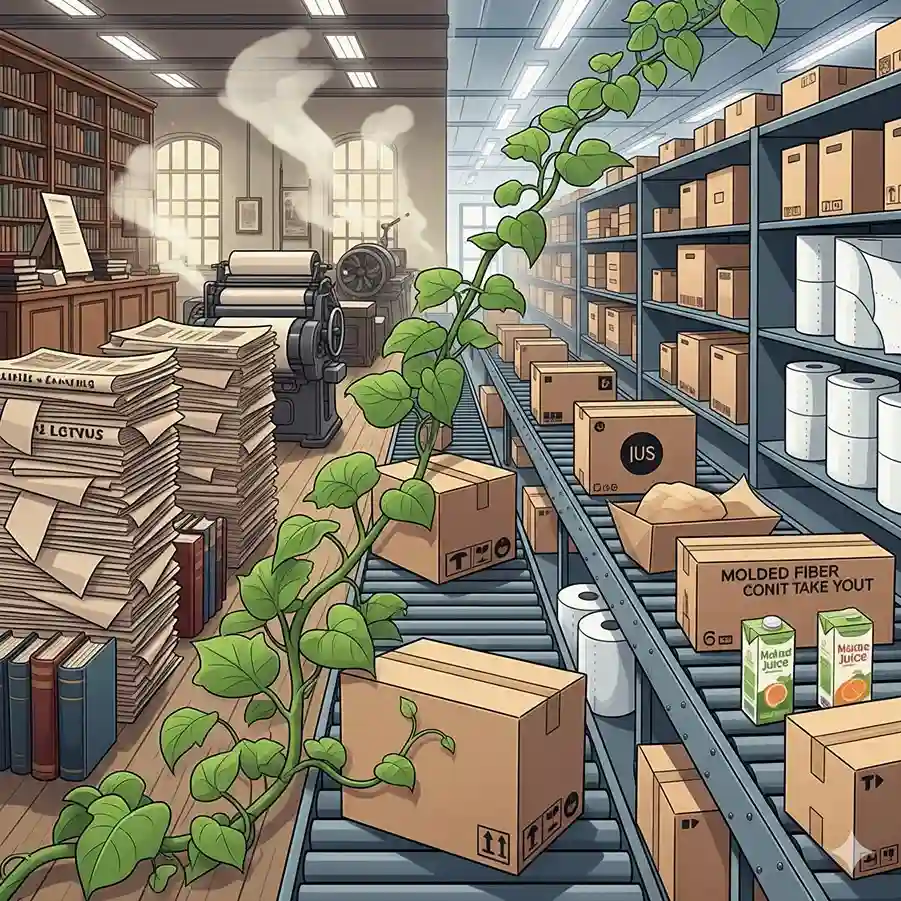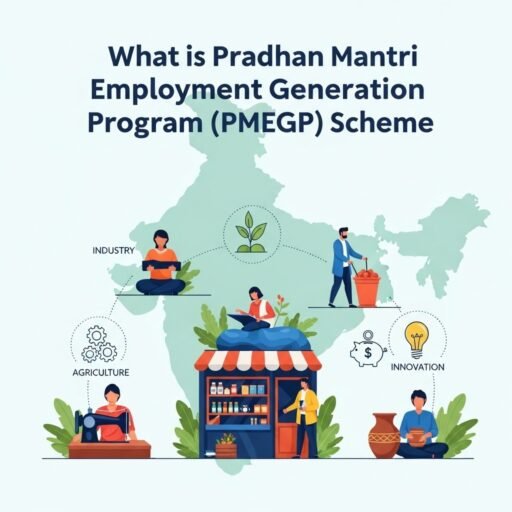It’s tempting to think of the paper industry in an age dominated by screens and digital communication as a vestige of a past era. Paper is still one of the most important and ubiquitous materials in the world economy. The paper industry, far from becoming irrelevant, is undergoing a radical transformation. It has shifted its focus away from traditional communication roles and towards sustainable packaging and hygiene. This dynamic industry is a mix of old-fashioned processes and new innovations, and it’s navigating the challenges posed by digitalization and environmental responsibilities to write a compelling chapter of growth.
This article explores the complex landscape of the global market for paper, analyzing its major segments, growth drivers and challenges. We will examine the innovations and trends shaping the future of the paper industry in an increasingly environmentally conscious world, with a focus on the rapidly growing Indian market.

Global Paper Industry Overview
Global pulp and paper industry is huge, estimated at USD 344.74 Billion in 2024. The market is expected to grow at a modest but steady rate, reaching USD 351.69 in 2025, and then growing to USD 416 by 2035. This represents a compounded annual growth (CAGR) around 1.71 percent. The growth is not the same in all sectors. The story of modern paper is one of strategic realignment. In other words, the decline of some segments has been compensated for by the boom of others.
Read More: Paper and Packaging Industry in India: Growth & Investment Opportunities
Geographically, Asia-Pacific, led by powerful economies such as China and India, dominates market share, with over half. This dominance stems from rapid industrialization and a growing middle class as well as the exponential growth in e-commerce. North America and Europe are still mature markets with significant growth. They focus on specialty products of high value and use innovative manufacturing techniques to meet environmental regulations.
Read Our Project Report: Paper Industry, Paper & Paper Board, Paper & Allied Products…
Key market segments: A tale of divergent fates
Paper is not one industry; there are many distinct segments with their own market dynamics.
Paperboard & Packaging Paper
This segment is the most important and has the highest performance. The global ecommerce boom has fueled a surge in demand for corrugated cardboard, containerboards, kraft papers, and paper bag. Paper-based packaging is also a sustainable alternative to plastic packaging due to a consumer backlash and regulatory pressure against single-use products. This includes everything from food containers, beverage cartons and retail bags, all the way up until protective mailers and retail bags. This segment is the main growth engine for the industry.
Hygiene & Tissue Paper
Another resilient and consistent growing sector. Global population growth, rapid city development, increasing disposable incomes, and increased awareness of personal hygiene are all factors that contribute to the steady demand for products such as facial tissues, toilet paper, paper towels and sanitary pads.
Writing and Printing Paper
The digitalization has the greatest impact on this segment. As a result of the transition to digital communication and online learning, as well as electronic documentation, demand for traditional books, office copy paper and notebooks has declined. The segment is still relevant. The demand for high-quality papers used in creative and premium printing applications and in the education sectors of emerging economies persists.
Newsprint
Over the last two decades, the newsprint segment has seen the most dramatic decline. Its market has been drastically reduced by the widespread shift in news consumption away from newspapers and towards online portals, mobile apps and other digital media. Newsprint mills have closed or repurposed machinery to produce packaging grades that are in demand.
Specialty papers
The high-value segment includes diverse products designed for specific purposes, including thermal paper for receipts and labels, currency, photographic paper, industrial filters, and self-adhesive paper. This segment is driven primarily by technological innovation, which often results in higher margins than bulk grades.

Focus on India: A high-growth frontier
India’s paper industry is one of the fastest growing markets in the entire world. The Indian paper industry is expected to grow at an impressive CAGR of over 7 percent with a market of more than USD 9 billion. The per capita consumption of paper, currently at 15-16 kg (significantly lower than the world average of 57 kg), is a key indicator. This gap will grow as the economy grows and literacy rates rise.
Read Our Book: Handbook on Pulp and Paper Processing
The Indian market: Key drivers
- Education sector: With the increasing emphasis on education, as well as an increase in literacy rates, there is a constant demand for books, notebooks and other stationery.
- Economic growth: An expanding economy drives industrial production and consumer expenditure, which directly boosts the demand for packaging materials of all kinds.
- Organized retail and E-commerce: Rapid expansion of organized retail, and the ecommerce boom is creating an unprecedented demand for sustainable and sophisticated packaging.
- Government initiatives: Policies such as the ban on plastics for single use and the “Make in India” initiative provide significant tailwinds for domestic paper manufacturers.
The Indian industry is faced with unique challenges. These include a dependency on imported wastepaper and wood pulp, as well as logistical difficulties and the need to upgrade technology in the numerous small mills.
Read More: Start an A4 Copier Paper Business in India with High Demand & Low Risk
The major growth drivers and pressing challenges
Driving the market forward:
- Sustainability Megatrend: Global movement away from plastics is the most powerful driver. Paper is biodegradable and recyclable. one can also recycle it.
- E-commerce Boom Online retail requires vast quantities of packaging for primary, secondary and tertiary products, which are almost exclusively paper-based.
- Consumerism and Urbanization: As disposable incomes increase and more people move into cities, packaged food, personal care products and other consumer goods are consumed, increasing demand for labels and paperboard.
Navigating Headwinds:
- Digital Disruption Continued encroachment by digital alternatives is a constant threat to the graphic-paper segment.
- Environmental Scrutiny The Paper Industry is Resource-Intensive, Requiring Significant Amounts of Wood, Water, and Energy. The paper industry is constantly under pressure to adopt sustainable forest practices (such as FSC certification), decrease its carbon footprint and manage wastewater efficiently.
- Raw Materials Volatility: The Industry is vulnerable to fluctuations in price and availability of raw materials including wood pulp and wastepaper. This can impact profitability.
Discover the Right Business for You With Our Startup Selector Tool
Conclusion – An Industry Reimagined
Paper industry in the 21st Century is a story of adaptability and resilience. The paper industry has successfully shifted from being primarily used as a communication medium to an essential enabler of global trade and champion of the circular economic system. Paper’s future is closely linked to innovation and sustainability. Companies that invest in resource efficient manufacturing, create novel paper-based products to replace less sustainable material, and leverage recycling effectively will thrive. Paper isn’t going away, but it is changing to fit the needs of a connected, modern and environmentally conscious society.
Paper Industry Market: Frequently Asked Questions
Q1. Is the paper industry growing or shrinking?
It’s kind of both. Paper for printing and newspapers is going down because people use phones and computers now. But paper for boxes and tissues is getting more popular. People buy lots of things online, so they need boxes. So, the paper industry is still doing well, just in a different way.
Q2. What’s making the paper market bigger right now?
The big reason is that people want to use less plastic. Governments and shoppers want things wrapped in paper, not plastic. So, companies use more paper for boxes, food, and shopping. That’s what’s helping the paper market grow these days.
Q3. How is the paper industry helping the planet?
Paper companies are trying to be better for nature. They use wood from safe forests. More old paper is must to make new paper. They try to save energy and water, and also make products that are easier to recycle. They want to make less waste and pollution.
Q4. What will happen to writing and printing paper?
People will keep using less of it. But some is still needed, like for special notebooks, nice flyers, or school books in some places. It won’t go away, but it will be less common.
Q5. Why is India’s paper market growing a lot?
People in India don’t use much paper yet, but that’s changing. The country’s economy is growing, more people are learning to read, and more people are buying things online. India has lots of young people too. So, companies think they will sell a lot more paper there soon.







